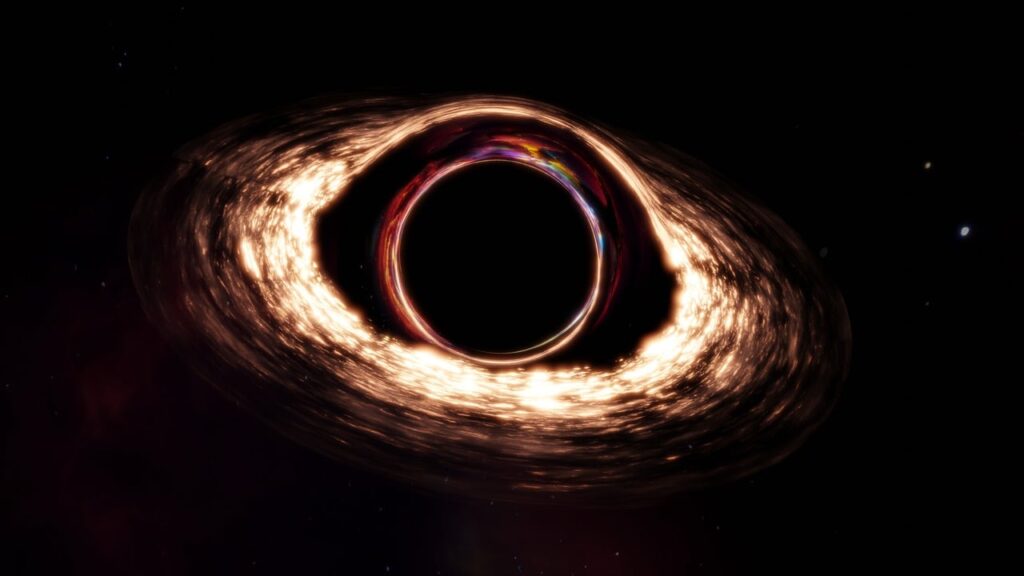Black holes, often considered some of the most mysterious objects in the universe, defy our understanding of physics. From the singularity at the center to the event horizon, everything about black holes challenges the conventional rules of space and time. Despite their enigma, black holes play an essential role in the cosmos and offer insight into the very fabric of the universe.
What is a Black Hole?
At its core, a black hole is a region in space where gravity is so intense that not even light can escape its pull. They are formed when massive stars collapse in on themselves at the end of their life cycles. The resulting gravitational force creates a “point of no return” called the event horizon, beyond which anything—matter, light, or even time itself—becomes trapped.
There are different types of black holes, ranging from stellar black holes, which form from collapsing stars to supermassive black holes that lurk at the centers of galaxies. While black holes vary in size, their ability to bend and distort the fabric of space-time remains consistent.
Inside the Event Horizon: What Lies Beyond?
Once you cross the event horizon, you enter the heart of the black hole, a place where the known laws of physics start to break down. What happens here is still a subject of intense debate among scientists. Here are some key phenomena believed to occur inside:
Time and Space Warp
One of the strangest aspects of black holes is the way they manipulate time and space. As you approach the event horizon, time appears to slow down relative to the outside universe. If you were to fall into a black hole, you would seem to freeze in time to an outside observer, never quite crossing the event horizon.
Singularity: The Heart of a Black Hole

At the very center of a black hole is the singularity—a point of infinite density where gravity is so intense that it warps space and time. Here, the usual laws of physics no longer hold. The singularity remains one of the greatest mysteries in astrophysics. Scientists believe that understanding this strange place could unlock answers to the long-sought theory of quantum gravity.
Spaghettification: A Stretching Experience
As you near the singularity, the gravity difference between your head and feet (for instance) would stretch you into an elongated form, a process known as spaghettification (the process where the extreme difference in gravitational pull stretches objects into thin shapes, resembling spaghetti). This would occur because the gravitational forces are incredibly stronger at the lower part of your body compared to the top. In essence, the closer you get to the singularity, the more intense the stretching becomes.
Theories About What Happens Inside
While much of the details are theoretical, scientists have proposed some fascinating possibilities about what could happen inside a black hole:
Wormholes: Portals to Other Universes?
Some theorists suggest that black holes could serve as wormholes, tunnels through space-time that could connect distant regions of the universe—or even provide access to other universes. These ideas, although speculative, offer a tantalizing glimpse at the possibility of faster-than-light travel or parallel universes.
Hawking Radiation: The Black Hole’s Slow Death
In the 1970s, physicist Stephen Hawking theorized that black holes aren’t entirely black. Instead, they emit faint radiation due to quantum effects near the event horizon, a phenomenon now called Hawking radiation. This radiation could, over a very long period, cause black holes to lose mass and eventually evaporate.
Information Paradox: What Happens to Information?
Another paradox revolves around what happens to the information about the matter swallowed by a black hole. According to classical physics, information should be lost forever, but quantum mechanics suggests it must be preserved. This information paradox is still an unsolved puzzle in modern physics, with some scientists proposing that information might be encoded on the surface of the event horizon in a form known as a hologram.
Myth and Misconceptions About Black Holes
While black holes are fascinating, they are also surrounded by myths and misconceptions. Let’s break down some of the most common ones:
Myth 1: Black Holes Suck Everything Around Them
It’s a common belief that black holes act like cosmic vacuum cleaners, sucking in everything around them. However, this is not entirely true. While black holes have strong gravity, they only affect objects that come too close. Objects at a safe distance will not be “sucked in.”
Myth 2: Anything that Falls into a Black Hole is Gone Forever
Many people believe that if something falls into a black hole, it’s lost for good. In reality, scientists are still studying the “information paradox.” They hypothesize that the information about the matter that falls into a black hole might not be lost forever, but rather encoded in some way at the event horizon.
Myth 3: Black Holes Are Just Empty Space
Although black holes have incredibly strong gravitational pulls, they are not empty spaces. They contain a singularity at the center, which is a point of infinite density and where gravity becomes infinitely strong. So, there’s far more going on inside a black hole than meets the eye!
Myth 4: Black Holes Are Just for Astrophysicists
While black holes might seem like the domain of astrophysicists, they have broader implications. Understanding black holes helps us explore fundamental questions about the nature of space, time, and the universe. Their study could one day lead to breakthroughs in quantum physics and cosmology.
Real-World Discoveries: Bringing the Mystery Closer
Despite their elusive nature, black holes have provided remarkable insights into astrophysics:
First Image of a Black Hole
In April 2019, the Event Horizon Telescope (EHT) unveiled the first-ever image of a black hole, located in the center of the galaxy M87. This image was a groundbreaking moment for astrophysics, providing a direct visual confirmation of a black hole’s existence.
Supermassive Black Holes at Galactic Centers
Nearly every large galaxy, including our own Milky Way, harbors a supermassive black hole at its center. These behemoths can be millions or even billions of times more massive than our sun. Their immense gravitational forces have a profound influence on the structure and behavior of galaxies.
Conclusion
The study of black holes pushes the limits of human knowledge, forcing us to rethink the nature of space, time, and matter. While we may never be able to visit one ourselves, the discoveries continue to reshape our understanding of the universe, and who knows—perhaps future advancements in technology will allow us to learn even more about these mysterious cosmic objects.





